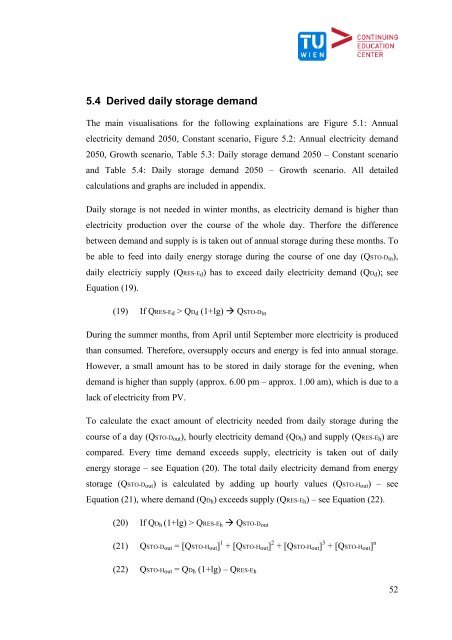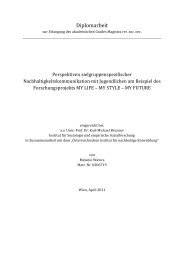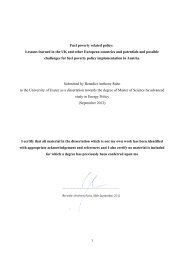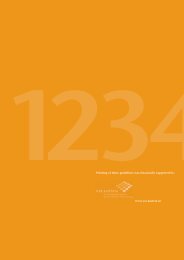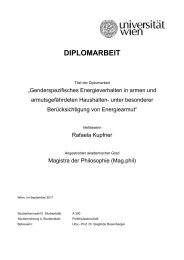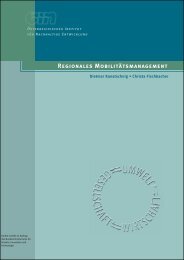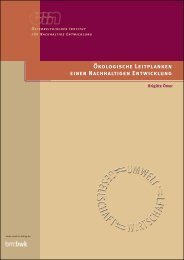The relevance of energy storages for an autarky of electricity supply ...
The relevance of energy storages for an autarky of electricity supply ...
The relevance of energy storages for an autarky of electricity supply ...
You also want an ePaper? Increase the reach of your titles
YUMPU automatically turns print PDFs into web optimized ePapers that Google loves.
5.4 Derived daily storage dem<strong>an</strong>d<br />
<strong>The</strong> main visualisations <strong>for</strong> the following explainations are Figure 5.1: Annual<br />
<strong>electricity</strong> dem<strong>an</strong>d 2050, Const<strong>an</strong>t scenario, Figure 5.2: Annual <strong>electricity</strong> dem<strong>an</strong>d<br />
2050, Growth scenario, Table 5.3: Daily storage dem<strong>an</strong>d 2050 – Const<strong>an</strong>t scenario<br />
<strong>an</strong>d Table 5.4: Daily storage dem<strong>an</strong>d 2050 – Growth scenario. All detailed<br />
calculations <strong>an</strong>d graphs are included in appendix.<br />
Daily storage is not needed in winter months, as <strong>electricity</strong> dem<strong>an</strong>d is higher th<strong>an</strong><br />
<strong>electricity</strong> production over the course <strong>of</strong> the whole day. <strong>The</strong>r<strong>for</strong>e the difference<br />
between dem<strong>an</strong>d <strong>an</strong>d <strong>supply</strong> is is taken out <strong>of</strong> <strong>an</strong>nual storage during these months. To<br />
be able to feed into daily <strong>energy</strong> storage during the course <strong>of</strong> one day (QSTO-Din),<br />
daily electriciy <strong>supply</strong> (QRES-Ed) has to exceed daily <strong>electricity</strong> dem<strong>an</strong>d (QDd); see<br />
Equation (19).<br />
(19) If QRES-Ed > QDd (1+lg) à QSTO-Din<br />
During the summer months, from April until September more <strong>electricity</strong> is produced<br />
th<strong>an</strong> consumed. <strong>The</strong>re<strong>for</strong>e, over<strong>supply</strong> occurs <strong>an</strong>d <strong>energy</strong> is fed into <strong>an</strong>nual storage.<br />
However, a small amount has to be stored in daily storage <strong>for</strong> the evening, when<br />
dem<strong>an</strong>d is higher th<strong>an</strong> <strong>supply</strong> (approx. 6.00 pm – approx. 1.00 am), which is due to a<br />
lack <strong>of</strong> <strong>electricity</strong> from PV.<br />
To calculate the exact amount <strong>of</strong> <strong>electricity</strong> needed from daily storage during the<br />
course <strong>of</strong> a day (QSTO-Dout), hourly <strong>electricity</strong> dem<strong>an</strong>d (QDh) <strong>an</strong>d <strong>supply</strong> (QRES-Eh) are<br />
compared. Every time dem<strong>an</strong>d exceeds <strong>supply</strong>, <strong>electricity</strong> is taken out <strong>of</strong> daily<br />
<strong>energy</strong> storage – see Equation (20). <strong>The</strong> total daily <strong>electricity</strong> dem<strong>an</strong>d from <strong>energy</strong><br />
storage (QSTO-Dout) is calculated by adding up hourly values (QSTO-Hout) – see<br />
Equation (21), where dem<strong>an</strong>d (QDh) exceeds <strong>supply</strong> (QRES-Eh) – see Equation (22).<br />
(20) If QDh (1+lg) > QRES-Eh à QSTO-Dout<br />
(21) QSTO-Dout = [QSTO-Hout] 1 + [QSTO-Hout] 2 + [QSTO-Hout] 3 + [QSTO-Hout] n<br />
(22) QSTO-Hout = QDh (1+lg) – QRES-Eh<br />
52


